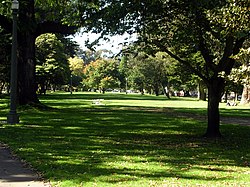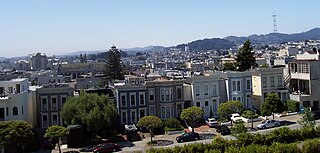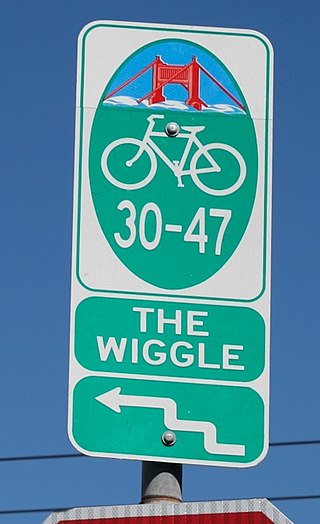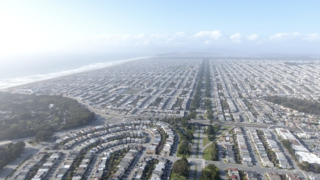
The Sunset District is a neighborhood located in the southwest quadrant of San Francisco, California, United States.

Haight-Ashbury is a district of San Francisco, California, named for the intersection of Haight and Ashbury streets. It is also called The Haight and The Upper Haight. The neighborhood is known as one of the main centers of the counterculture of the 1960s.

Golden Gate Park is an urban park between the Richmond and Sunset districts of San Francisco, United States. It is the largest park in the city, containing 1,017 acres (412 ha), and the third-most visited urban park in the United States, with an estimated 24 million visitors annually.

The Central Freeway is a roughly one-mile (1.5 km) elevated freeway in San Francisco, California, United States, connecting the Bayshore/James Lick Freeway with the Hayes Valley neighborhood. Most of the freeway is part of US 101, which exits at Mission Street on the way to the Golden Gate Bridge. The freeway once extended north to Turk Street, and initially formed part of a loop around downtown, but was damaged along with the Embarcadero in the 1989 Loma Prieta earthquake; both highways have since been replaced with the surface-level Octavia Boulevard and Embarcadero, respectively.

Hayes Valley is a neighborhood in the Western Addition district of San Francisco, California. It is located between the historical districts of Alamo Square and the Civic Center. Victorian, Queen Anne, and Edwardian townhouses are mixed with high-end boutiques, restaurants, and public housing complexes. The neighborhood gets its name from Hayes Street, which was named for Thomas Hayes, San Francisco's county clerk from 1853 to 1856 who also started the first Market Street Railway franchise.
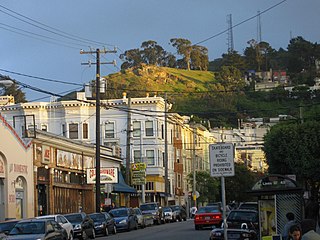
Cole Valley is a small neighborhood in San Francisco, California. It borders Golden Gate Park to the north, Haight-Ashbury to the northeast, The Castro to the east. and Twin Peaks to the south. Near Kezar Stadium, Cole Valley is the smallest neighborhood in the city.

Haight Street is the principal street in San Francisco's Haight-Ashbury district, also known as the Upper Haight due to its elevation. The street stretches from Market Street, through the Lower Haight neighborhood, to Stanyan Street in the Upper Haight, at Golden Gate Park. In most blocks it is residential, but in the Upper and Lower Haight it is also a neighborhood shopping street, with residences above the ground floor shops. It is named after California pioneer and exchange banker Henry Haight (1820–1869).
The Lower Haight is a neighborhood, sometimes referred to as Haight–Fillmore, in San Francisco, California.

Octavia Boulevard is a major street in San Francisco, California, that replaced the Hayes Valley portion of the damaged two-level Central Freeway. Once a portion of Octavia Street alongside shadowy, fenced-off land beneath the elevated U.S. Route 101 roadway, Octavia Boulevard was redeveloped and redesigned upon the suggestion of Mark Jolles of San Francisco.
The 49-Mile Scenic Drive is a designated scenic road tour highlighting much of San Francisco, California. It was created in 1938 by the San Francisco Down Town Association to showcase the city's major attractions and natural beauty during the 1939 Golden Gate International Exposition.

Recreation Park was the name applied to several former baseball parks in San Francisco, California in the late 19th century and early 20th century.

Stanyan Street is a north–south street in San Francisco, California marking the eastern side of the Golden Gate Park and the western side of the Panhandle. It is named after Charles H. Stanyan, a city supervisor from 1866 to 1869 who was on the committee which sited the park.

Sue Bierman was a civic leader in San Francisco, serving on the San Francisco Planning Commission, the Board of Supervisors, and the Port Commission.

The William McKinley Memorial, is a statue honoring the assassinated United States President William McKinley which stands at the foot of the Panhandle Park, San Francisco, California, facing the DMV across Baker Street. Created by Robert Ingersoll Aitken (1878–1949) in 1904, the Monument was dedicated in 1903 by President Theodore Roosevelt, who succeeded McKinley after his assassination in 1901. The monument was unveiled on November 24, 1904 at the entrance to the Golden Gate Park panhandle. Over 5,000 people came to the unveiling. Speeches were made by former Mayor James D. Phelan, Mayor Eugene Schmitz, John McNaught, and others.

33 Ashbury/18th Street is a trolleybus line operated by the San Francisco Municipal Railway. The route is descendant from the first trolleybus service to open in San Francisco.
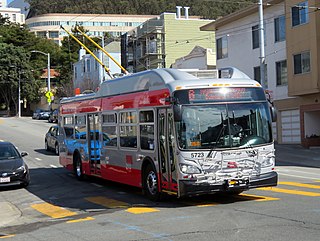
6 Haight/Parnassus is a trolleybus line operated by the San Francisco Municipal Railway (Muni). It connects the Financial District to the Inner Sunset and Forest Hill via Haight-Ashbury.

7 Haight/Noriega is a bus route operated by the San Francisco Municipal Railway (Muni). It connects the central business district to the Outer Sunset via Haight-Ashbury.
